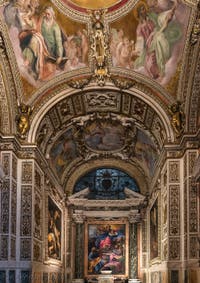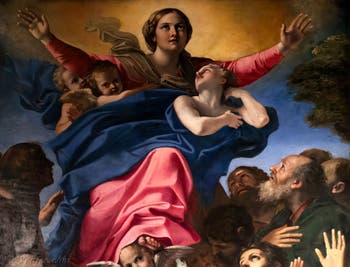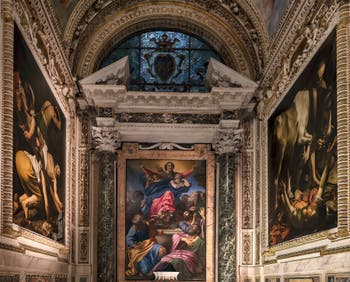Popolo Art History | Location | Opening Hours Tickets | Authorisations
Art History History | Cerasi | Caravaggio Peter | Caravaggio Paul | Chigi Borgia
Santa Maria del Popolo, the Cerasi Chapel: Caravaggio and Annibale Carracci
The frescoes and paintings by Pinturicchio that can be admired in this church are superb, as are the sculptures by Bernini.
The Cerasi Chapel But the "must-sees" are the two paintings by Caravaggio in the small Cerasi Chapel, the "Crucifixion of Saint Peter" and the "Conversion of Saint Paul", at the back and left of the apse.
In 1600, Tiberio Cerasi, treasurer to Pope Clement VIII, bought one of the chapels in the church and decided to have it decorated by the emerging painters of the time, Caravaggio and Annibale Carracci, while the architecture of the Chapel was entrusted to Carlo Maderno, the architect of the façade of St. Peter's Basilica.
Cerasi, in addition to being the Pope's treasurer, was a man of great culture, attentive to the artistic trends of his time.
At the time when Cerasi entrusted the construction and decoration of his Chapel to these three artists, they were arguably the most original and innovative in their art.
Caravaggio was less than thirty years old when Cerasi entrusted him with this contract, and was just beginning to gain recognition.

Annibale Carracci, Assumption of the Virgin Annibale Carracci painted the beautiful Assumption of the Virgin, which hangs above the altar between the two paintings by Caravaggio.
A small detail from Cerasi's contract with Caravaggio dated 24 September 1600: he specified that the commissioned paintings were to be painted on cypress wood.
He no doubt hoped that cypress wood would be more reliable than canvas in the face of possible humidity problems in the Chapel.
Or perhaps it was a resurgence of the old pictorial tradition, which had fallen into disuse since the Middle Ages.
Unfortunately, Tiberio Cerasi did not have the pleasure of admiring these two masterpieces by Caravaggio, as he died on 3 May 1601, some twenty days before the scheduled delivery date for the paintings.

The Cerasi Chapel Following Cerasi's death, Caravaggio delivered his paintings to those who had become his heirs, namely the members of the Confraternity of Santa Maria della Consolazione, who... refused them.
Perhaps they had deemed them inconsistent with Church doctrine.
Caravaggio was therefore forced not only to start all over again, but also to reinterpret each of the two themes imposed in the initial commission.
Except that these new versions were painted on canvas.
The medium was irrelevant, as the final result was absolutely superb.
So much so that, according to art critic Roberto Longhi, these two paintings are the most revolutionary works in the entire history of sacred art.
Art History History | Cerasi | Caravaggio Peter | Caravaggio Paul | Chigi Borgia
Popolo Art History | Location | Opening Hours Tickets | Authorisations
Back to Top of Page

